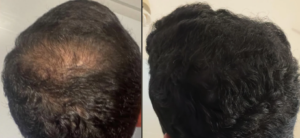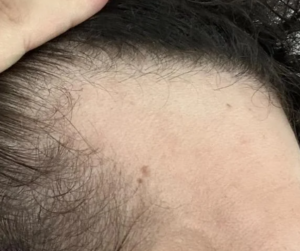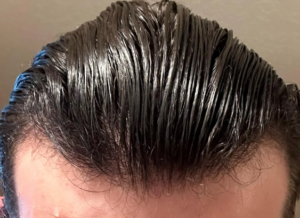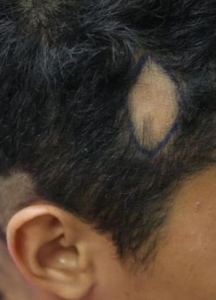The photos speak for the value achieved. I have seen such reversals in men of all ages. The percentage of such reversals is tied to the onset of the balding and the degree to which hair loss was present. In the photo below, the balding is not complete, and there are clearly many miniaturized hairs present, which predicts good success for various medical treatment modalities like finasteride and oral minoxidil.
I got scheduled for a hair transplant in 8 weeks and prescribed oral minoxidil at the same time (was already on fin). Should I wait to see how the oral min goes before the transplant?
I always like to see the my patients try all of the available medications before I would do a hair transplant on them. Sometimes I am very surprised with the results. The frontal hairlines are usually unresponsive to these medications if your hairline loss is over 5 years old and you are over 25.
Over and over again, we see these amazing turnarounds with microneedling, finasteride and minoxidil. The microneedling here is the key. What is particularly important to note, is that the frontal hairline has regrown hair, a real challenge to any treatment modality alone, and that includes adding finasteride and minoxidil.
The SMP, unfortunately, can be seen from the photo shown but it is a well done job. You should wear your hair slightly longer as you suggested, as it would look better and make the SMP not detectable. It is almost impossible to tell the hair growth you are reverencing because the SMP makes comparisons difficult.
https://www.instagram.com/reel/DF_Fm0pO4C6/?igsh=b240dzR6MTd5bWlw
A good video is worth a 1000 words
I feel that my life is ruined. I know that my dad is completely bald. Does this mean that this will be my fate as well?
You can do this the classy way and see a good dermatologist to make the diagnosis. The key here is to find out if you are really on the way with genetic balding. If the answer is no, you don’t have to commit to a lifetime of medications, and certainly not if you are going to treat yourself with drugs to handle the worry that you are going to follow your father’s pattern. If you are in the balding process, you need to do it smartly. Follow a good doctor’s advice. Usually, men who are going to develop the most advanced hair loss pattern, like your dad, show it earlier than 23 years old, and many of them reach their advanced pattern by the time they are 26.
https://www.thecut.com/article/med-spa-hair-loss-treatments-balding-men-botox.html
The article calls out Ozympic as producing hair loss; however, I suspect that when people lose weight rapidly, hair loss is often a known side effect of a “negative nitrogen balance”, essentially losing your body proteins and fat. The body is intrinsically smart, so it knows that when you are losing weight, it has to sacrifice functions that are not critical to living, and hair growth is one of those dispensable functions. This is especially true in men with genetic hair loss, as weight loss can trigger genetic hair loss or accelerate what is already going on.
The report I got said:
“A Turkish doctor called from Germany and said that approximately 16 clinics in Germany and the Netherlands where Turkish technicians perform hair transplants have been inspected by health authorities, and many of them have been temporarily closed; the equipment used was said to be not CE Compliant or nut sufficiently sterilized. Some technicians were also deported as they were on Visas that didn’t allow them to work.”
Another source echoed this story for France and Belgium. I have also been informed that many of the 5000 clinics in Turkey are shutting down for similar reasons and due to a doctor’s absence.
Both corners of my hairline were the same before I started my routine of 5% minoxidil, finasteride and microneedling with a 0.75mm needle.
Congrats! This is an awesome response. Nothing like persistence and follow-through. The value of microneedling is, I believe, the key to your success, but it is clearly only part of the solution.
I believe that minoxidil rarely works on the transplanted hair but assuming that some of your residual native hair remains, it may help fill that hair out and retain it.
I have seen a few patients who have responded better to finasteride at a higher dose, suggesting that that particular individual just needed a higher dose. If you understand Bell Curves, the 1mg dose determined as the ideal dose by Merck in their original studies used a Bell Curve to make that determination. We can sit on either side of that Bell Curve as we find the ideal dose of finasteride for us.
[If you have any questions, you can reach me at williamrassman33@gmail.com]
That makes no sense to me, as adding topical finasteride while you are taking oral finasteride at the 1mg dose, will add blood levels of finasteride. With topical finasteride, the drug will come across the scalp and go into your body. There is therefore no reason to add topical finasteride once you are on the proper dose of oral finasteride.
How do you tell if you have DUPA vs Diffused thinning MPB? I’ve searched online, and haven’t really found substantial answers. I have diffused thinning across the top of my scalp, with it being noticeably thinner at my crown. Some hairline recession as well. I got a scalp biopsy done and derm said MPB, but I don’t think he took a close look at the sides and back of my hair. I’ve deff noticed some thinning and hair loss there. Is it over for me? So is the difference of DUPA that you also lose hair in donor area ?
Diffuse Unpatterned Alopecia (DUPA) impacts all of the hair on the head, even the areas around the sides and back of the head. What I do, is count miniaturized hairs in the “donor” area to see if miniaturization exceeds 20%. Some doctors require a higher threshold. Unfortunately, your doctor didn’t biopsy the proper area. Here are some examples of DUPA, early and late stages with explanations on how to make the diagnosis:
- https://baldingblog.com/possible-end-stage-dupa-in-class-7-patient-photo/ (grossly evident)
- https://baldingblog.com/is-this-dupa-photo/ (Early DUPA with subtle changes including depigmentation of hairs)
- https://baldingblog.com/do-i-have-dupa-photo/ (A great view of a Classic case of DUPA)
I hope this helps you understand the DUPA diagnosis. Never get a hair transplant if you have DUPA as the transplant will usually fail at some point in the near future.
In evaluating this spot, a knowledgable surgeon will know or want to find out:
1- This location is not typical for Triangular alopecia as it is too far back from the temple peak.
2- What does the trichoscopy show as there are hairs within the bald spot that might shed light on the diagnosis (will rule in or out alopecia areata)
3- Most likely that this is not genetic patterned balding as it is not located in the patterns for such balding
4- This is a clean scar sitting inside normal hair, likely a form of alopecia that has a clear “cut” border
It turns out that this lesion was biopsied, and the diagnosis was definitive for Citrical Alpecia (scarring alopecia). This man had this for many years, and it was stable, suggesting that the disease had already done its damage and could be, therefore, transplanted as was done with good immediate results. The problem with such diseases is that:
1- It could return at the site and kill all of the transplanted hair
2- it could appear at another site and do the same damage
3- if the disease was active during the transplant, it would either immediately kill the new hairs as they started to grow or slowly kill off the new hairs over time.
Page 4 of 1247










